Spatial Variability of Grouting Layer of Shield Tunnel and Its Effect on Ground Settlement
Abstract
1. Introduction
2. Spatial Variability of Grouting Layers
3. Modeling Aspects
3.1. FEM Model
3.2. Random Model
4. Results and Analysis
5. Engineering Applications
6. Conclusions
Author Contributions
Funding
Acknowledgments
Conflicts of Interest
References
- Peck, R.B. Deep excavations and tunneling in soft ground. Proc. 7th ICSMFE 1969, 2019, 225–290. [Google Scholar]
- Bolton, M.D.; Lu, Y.C.; Sharma, J.S. Centrifuge models of tunnel construction and compensation grouting, Int. In Proceedings of the International Symposium on Geotechnical Aspects of Underground Construction in Soft Ground, London, UK, 15 April 1996; A.A. Balkema: Brookfield, WI, USA, 1996; pp. 471–477. [Google Scholar]
- Nomoto, T.; Imamura, S.; Hagiwara, T.; Kusakabe, O.; Fujii, N. Shield Tunnel Construction in Centrifuge. J. Geotech. Geoenviron. Eng. 1999, 125, 289–300. [Google Scholar] [CrossRef]
- Chapman, D.N.; Ahn, S.K.; Hunt, D.V. Investigating ground movements caused by the construction of multiple tunnels in soft ground using laboratory model tests. Can. Geotech. J. 2007, 44, 631–643. [Google Scholar] [CrossRef]
- Marshall, A.M.; Mair, R.J. Tunneling beneath driven or jacked end-bearing piles in sand. Can. Geotech. J. 2011, 48, 1757–1771. [Google Scholar] [CrossRef]
- Mathew, G.V.; Lehane, B.M. Numerical back-analyses of greenfield settlement during tunnel boring. Can. Geotech. J. 2013, 50, 145–152. [Google Scholar] [CrossRef]
- Moussaei, N.; Khosravi, M.H.; Hossaini, M.F. Physical modeling of tunnel induced displacement in sandy grounds. Tunn. Undergr. Space Technol. 2019, 90, 19–27. [Google Scholar] [CrossRef]
- Xiang, Y.; Liu, H.; Zhang, W.; Chu, J.; Zhou, N.; Xiao, Y. Application of transparent soil model test and DEM simulation in study of tunnel failure mechanism. Tunn. Undergr. Space Technol. 2018, 74, 178–184. [Google Scholar] [CrossRef]
- Sharifzadeh, M.; Kolivand, F.; Ghorbani, M.; Yasrobi, S. Design of sequential excavation method for large span urban tunnels in soft ground-Niayesh tunnel. Tunn. Undergr. Space Technol. 2013, 35, 178–188. [Google Scholar] [CrossRef]
- Do, N.A.; Dias, D.; Oreste, P.; Djeran-Maigre, I. Three-dimensional numerical simulation of a mechanized twin tunnels in soft ground. Tunn. Undergr. Space Technol. 2014, 42, 40–51. [Google Scholar] [CrossRef]
- Chakeri, H.; Özçelik, Y.; Ünver, B. Investigation of ground surface settlement in twin tunnels driven with EPBM in urban area. Arab. J. Geosci. 2014, 8, 7655–7666. [Google Scholar] [CrossRef]
- Miro, S.; König, M.; Hartmann, D.; Schanz, T. A probabilistic analysis of subsoil parameters uncertainty impacts on tunnel-induced ground movements with a back-analysis study. Comput. Geotech. 2015, 68, 38–53. [Google Scholar] [CrossRef]
- Goh, A.; Xiao, Y.; Xiang, Y.; Zhang, W.; Zhang, Y. Determination of earth pressure balance tunnel-related maximum surface settlement: A multivariate adaptive regression splines approach. Bull. Int. Assoc. Eng. Geol. 2016, 77, 489–500. [Google Scholar] [CrossRef]
- Zheng, G.; Yang, X.; Zhou, H.; Du, Y.; Sun, J.; Yu, X. A simplified prediction method for evaluating tunnel displacement induced by laterally adjacent excavations. Comput. Geotech. 2018, 95, 119–128. [Google Scholar] [CrossRef]
- Xiao, L.; Huang, H.; Zhang, J. Effect of soil spatial variability on ground settlement induced by shield tunneling. Geo-Risk 2017, 2017, 330–339. [Google Scholar]
- Huber, M.; Hicks, M.A.; Vermeer, P.A.; Moormann, C. Probabilistic calculation of differential settlement due to tunneling. In Proceedings of the 8th International Probabilistic Workshop, Akademia Morska, Szczecin, Poland, 18–19 November 2010; pp. 1–13. [Google Scholar]
- Rowe, R.K.; Kack, G.J. A theoretical examination of the settlements induced by tunnelling: Four case histories. Can. Geotech. J. 1983, 20, 299–314. [Google Scholar] [CrossRef]
- Loganathan, N.; Poulos, H.G. Analytical Prediction for Tunneling-Induced Ground Movements in Clays. J. Geotech. Geoenviron. Eng. 1998, 124, 846–856. [Google Scholar] [CrossRef]
- Oh, J.Y.; Ziegler, M. Investigation on Influence of Tail Void Grouting on the Surface Settlements during Shield Tunneling Using a Stress-Pore Pressure Coupled Analysis. KSCE J. Civ. Eng. 2014, 18, 803–811. [Google Scholar] [CrossRef]
- Teachavorasinskun, S. Evaluation of liner responses due to non-uniform tail void grouting pressure. Geomech. Geoengin. 2018, 13, 226–232. [Google Scholar] [CrossRef]
- Liao, S.; Xu, J.; Jiao, Q. Identifying TBM tunneling defects through recognition of ground settlement patterns. In Proceedings of the GeoCongress 2012: State of the Art and Practice in Geotechnical Engineering, Oakland, CA, USA, 25–29 March 2012; pp. 3179–3188. [Google Scholar]
- Wang, Z.; Xie, X. Design and optimization of the antenna applied for detecting the voids in tunnel lining by GPR. In Proceedings of the 2012 14th International Conference on Ground Penetrating Radar, Shanghai, China, 4–8 June 2012; IEEE: New York, NY, USA, 2012. [Google Scholar]
- Yu, Q.M.; Zhou, H.L.; Wang, Y.H.; Duan, R.X. Quality monitoring of metro grouting behind segment using ground penetrating radar. Constr. Build. Mater. 2016, 110, 189–200. [Google Scholar] [CrossRef]
- Ding, W.; Duan, C.; Zhu, Y.; Zhao, T.; Huang, D.; Li, P. The behavior of synchronous grouting in a quasi-rectangular shield tunnel based on a large visualized model test. Tunn. Undergr. Space Technol. 2019, 83, 409–424. [Google Scholar] [CrossRef]
- Zhang, Z.X.; Liu, C.; Huang, X.; Kwok, C.Y.; Teng, L. Three-dimensional finite-element analysis on ground responses during twin-tunnel construction using the URUP method. Tunn. Undergr. Space Technol. 2016, 58, 133–146. [Google Scholar] [CrossRef]
- Wen-Jie, S.; Yan-Yong, X. A continuous upper bound limit analysis for the transverse stability of shallow shield tunnelling in undrained clays. Revue Française De Génie Civil 2020, 24, 401–422. [Google Scholar] [CrossRef]
- Jiang, H.; Jiang, Y.S.; Huang, M.L.; Chen, Z.Q. Study on Soil Improvement of TBM’S Commencement and Arrival in Water-Rich Sand Stratum. Appl. Mech. Mater. 2011, 90–93, 2119–2124. [Google Scholar] [CrossRef]
- Ching, J.; Phoon, K.-K.; Chen, Y.-C. Reducing shear strength uncertainties in clays by multivariate correlations. Can. Geotech. J. 2010, 47, 16–33. [Google Scholar] [CrossRef]
- Papaioannou, I.; Straub, D. Reliability updating in geotechnical engineering including spatial variability of soil. Comput. Geotech. 2012, 42, 44–51. [Google Scholar] [CrossRef]
- Li, X.-Y.; Zhang, L.-M.; Gao, L.; Zhu, H. Simplified slope reliability analysis considering spatial soil variability. Eng. Geol. 2017, 216, 90–97. [Google Scholar] [CrossRef]
- Jiang, S.; Li, D.; Cao, Z.; Zhou, C.; Phoon, K.K. Efficient system reliability analysis of slope stability in spatially variable soils using Monte Carlo simulation. J. Geotech. Geoenviron. Eng. 2014, 141, 04014096. [Google Scholar] [CrossRef]
- Phoon, K.-K.; Tang, C. Characterisation of geotechnical model uncertainty. Georisk Assess. Manag. Risk Eng. Syst. Geohazards 2019, 13, 101–130. [Google Scholar] [CrossRef]
- Tang, C.; Phoon, K.-K. Characterization of model uncertainty in predicting axial resistance of piles driven into clay. Can. Geotech. J. 2019, 56, 1098–1118. [Google Scholar] [CrossRef]
- Phoon, K.K.; Kulhawy, F.H. Characterization of geotechnical variability. Can. Geotech. J. 1999, 36, 612–624. [Google Scholar] [CrossRef]
- Fenton, G.A.; Griffiths, D. Bearing-capacity prediction of spatially random soils. Can. Geotech. J. 2003, 40, 54–65. [Google Scholar] [CrossRef]
- Lloret-Cabot, M.; Fenton, G.A.; Hicks, M.A. On the estimation of scale of fluctuation in geostatistics. Georisk Assess. Manag. Risk Eng. Syst. Geohazards 2014, 8, 129–140. [Google Scholar] [CrossRef]
- Fenton, G.A.; Griffiths, D.V. Probabilistic foundation settlement on spatially random soil. J. Geotech. Geoenviron. Eng. 2002, 128, 381–390. [Google Scholar] [CrossRef]
- BSI. BS EN 1997–2:2007: Eurocode 7. Geotechnical Design. Ground Investigation and Testing; BSI: London, UK, 2007. [Google Scholar]
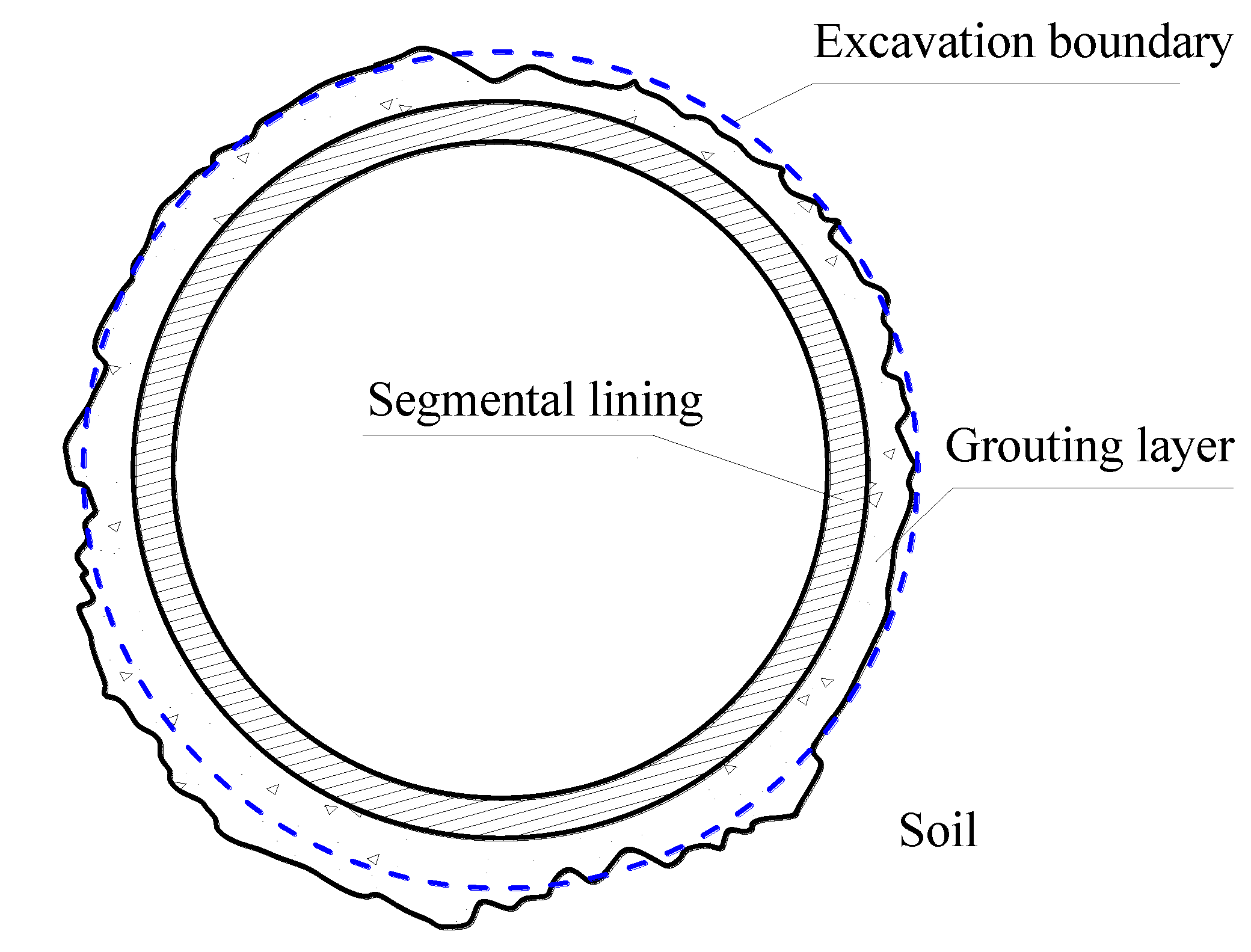


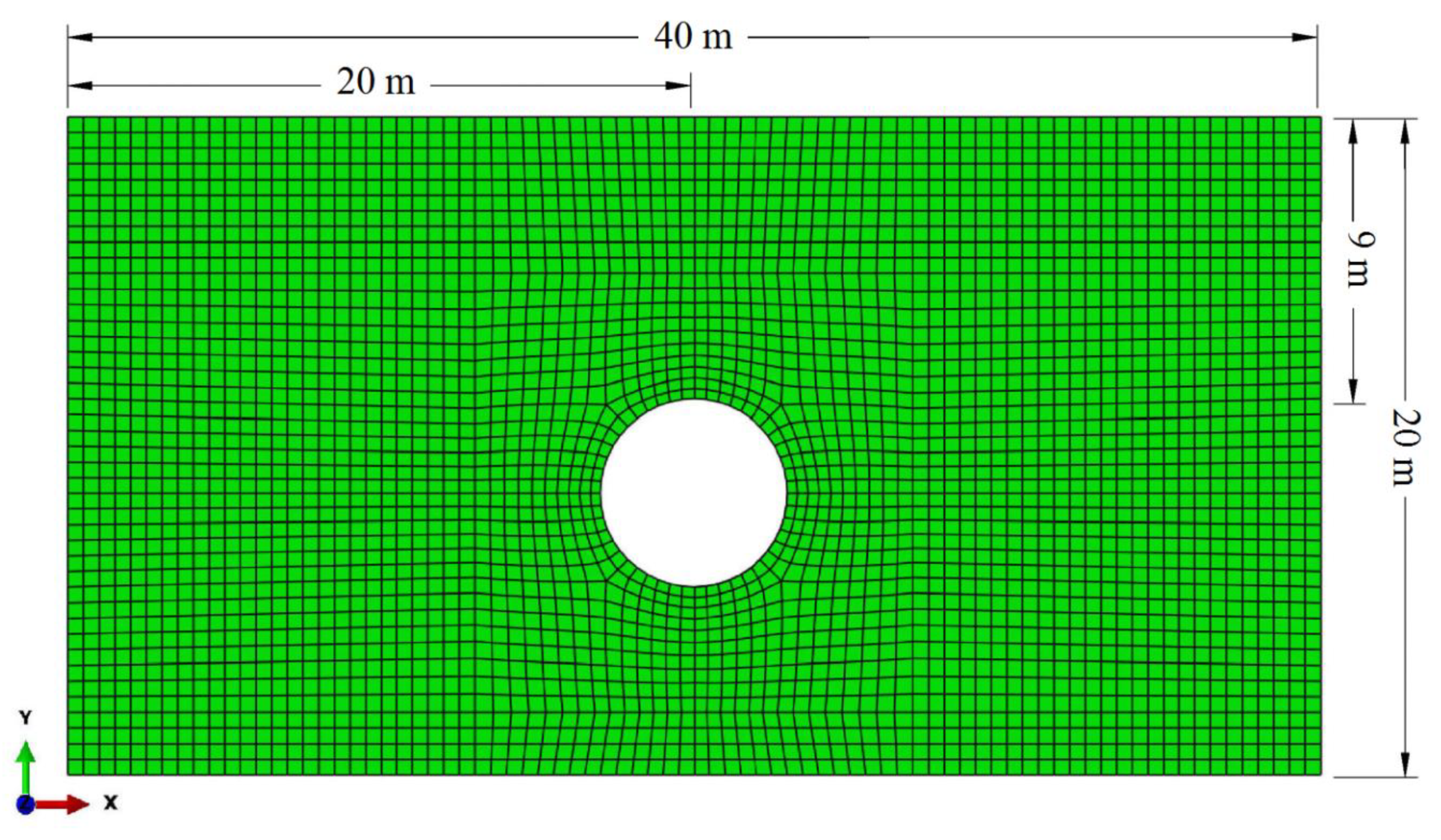

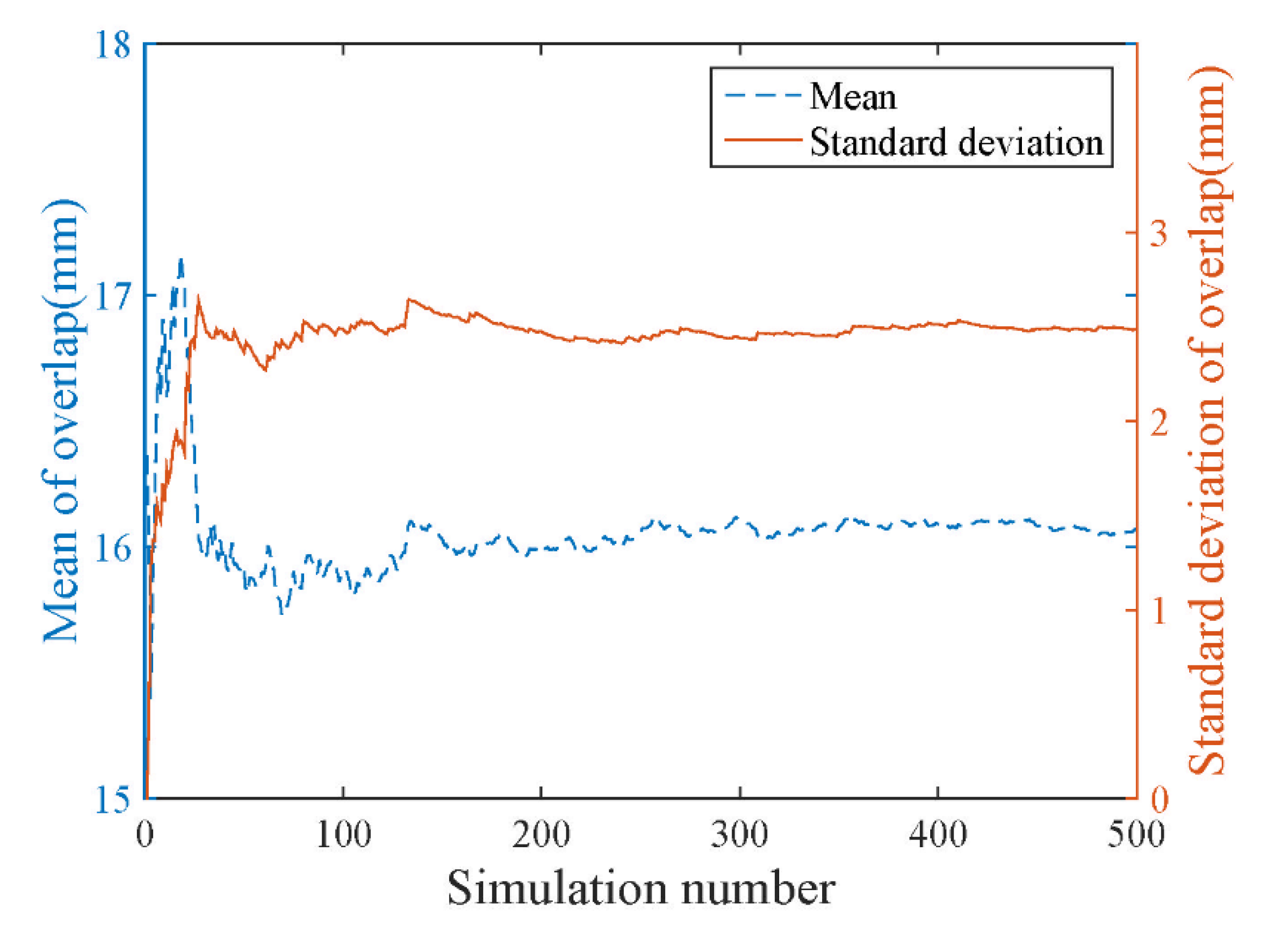


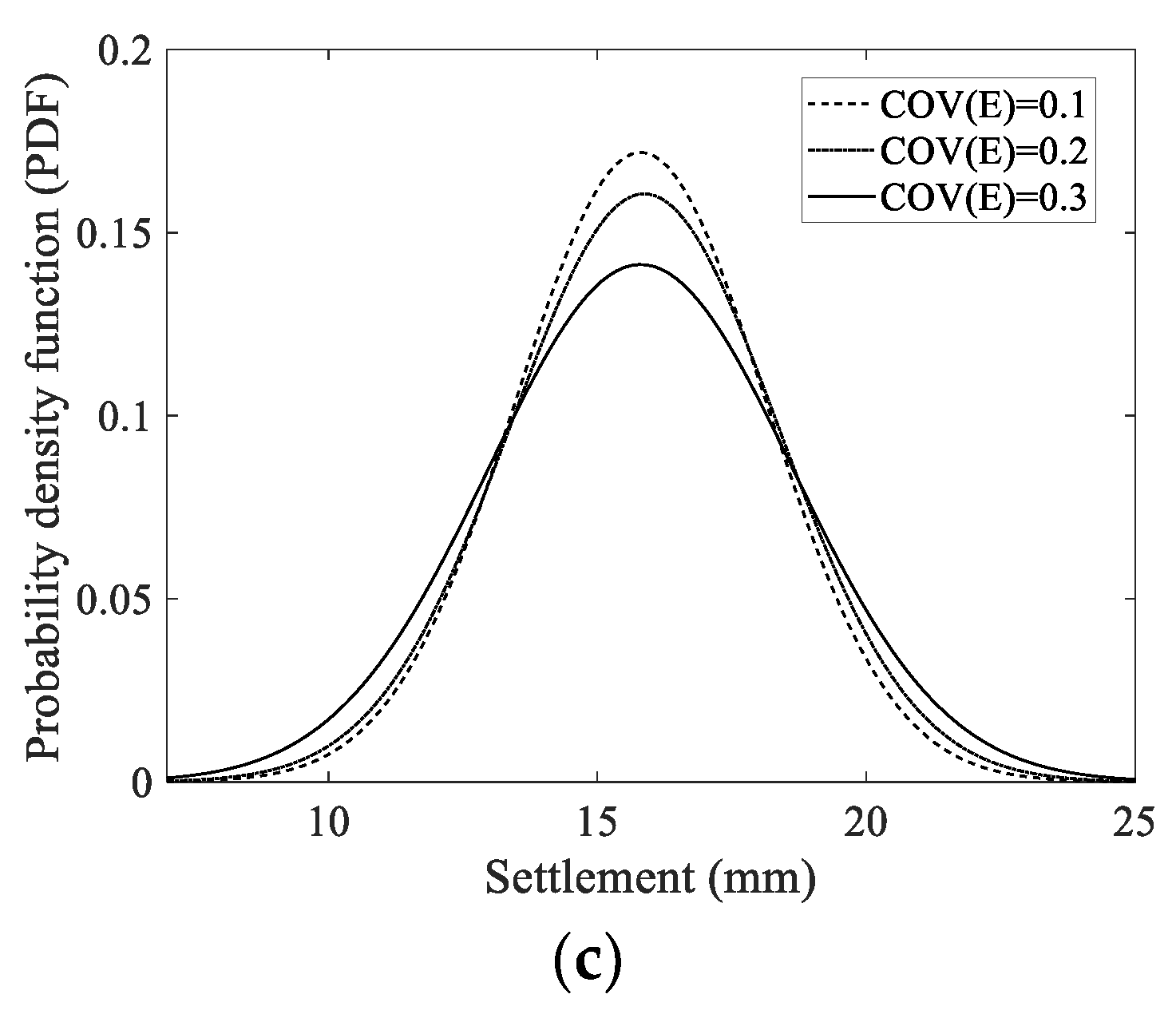
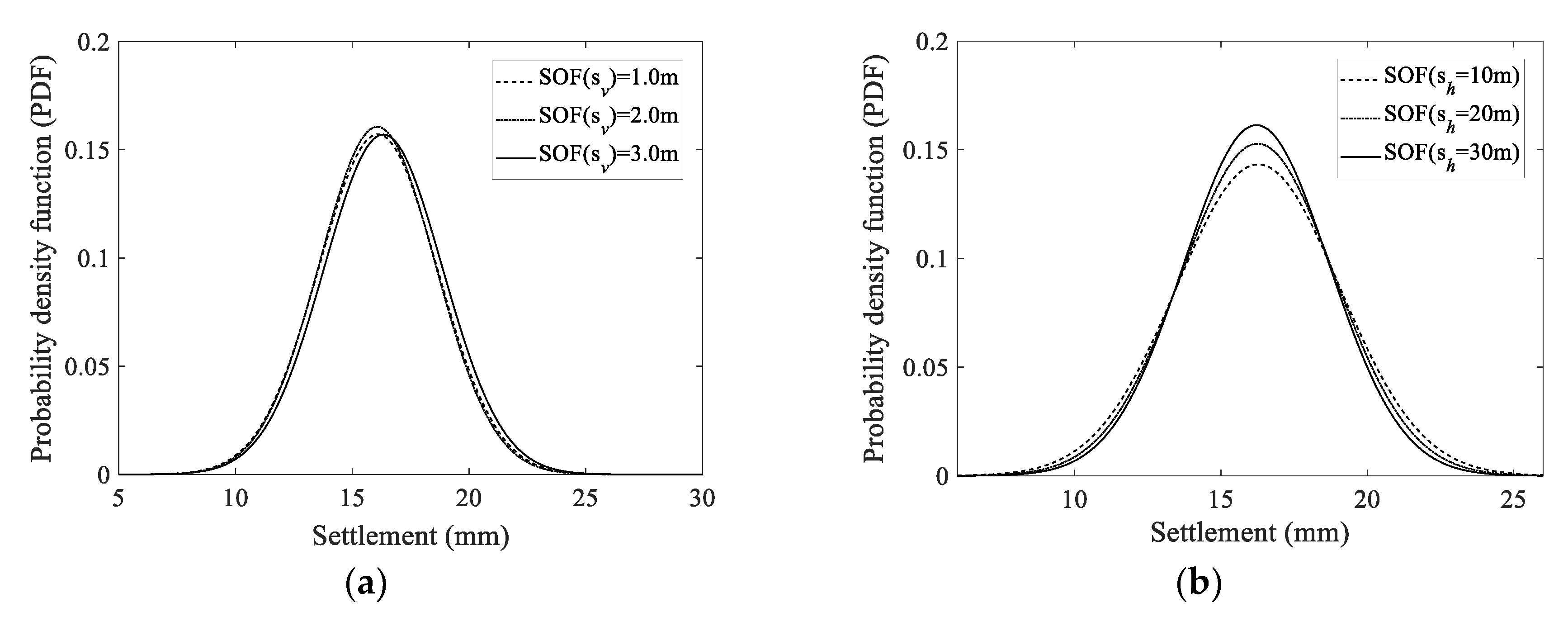

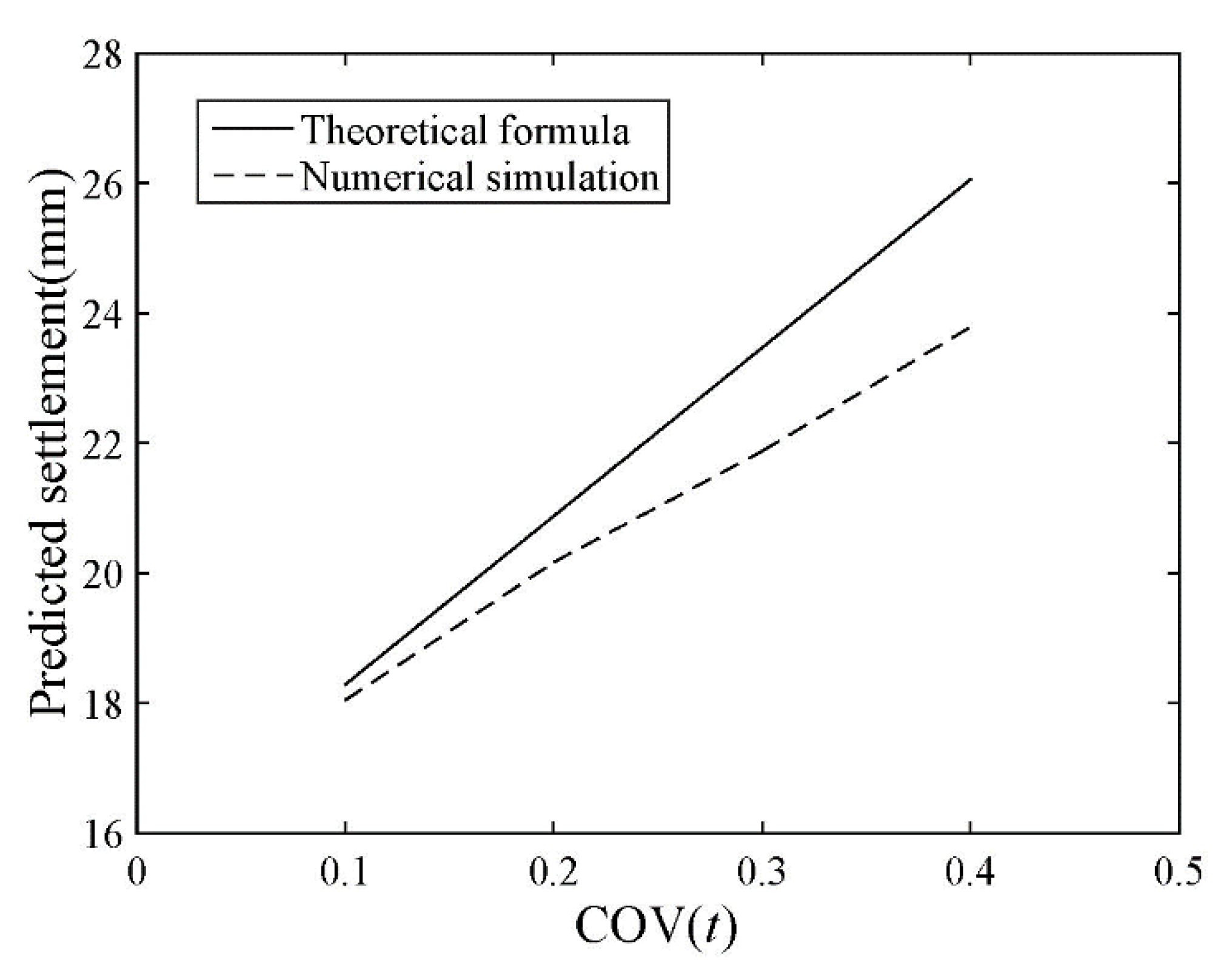
| Source. | Mean | Span | COV | Test Method |
|---|---|---|---|---|
| Yu et al. (2016) [23] | 300 mm | 220 mm–380 mm | 0.1–0.20 | Ground penetrating radar (GPR) |
| Ding et al. (2019) [24] | 169 mm | 105 mm–240 mm | 0.15–0.40 | Large visualized model test |
| Deterministic Variables | Value | Input Variables | Mean Value (μ) | COV (%) | SOF (m) | |
|---|---|---|---|---|---|---|
| Dl (m) | 5.6 | c (kPa) | 10 | 0.20 | 10 | 2.0 |
| D (m) | 6.0 | φ (°) | 25 | 0.10 | ||
| (mm) | 200 | E (MPa) | 20 | 0.15 | ||
| γs (kN/m3) | 20 | (mm) | 20 | 0.20 | – | |
| v | 0.2 | (mm) | 180 | |||
| Remarks | COV (c) | COV (φ) | COV (E) | SOF (soil)/m | (mm) | (mm) | COV (t) | |
|---|---|---|---|---|---|---|---|---|
| sv | sh | |||||||
| Reference case | 0.2 | 0.1 | 0.15 | 2.0 | 10 | 180 | 20 | 0.2 |
| Effect of COV of soil cohesion | 0.1 * | 0.1 | 0.15 | 2.0 | 10 | 180 | 20 | 0.2 |
| 0.2 * | 0.1 | 0.15 | 2.0 | 10 | 180 | 20 | 0.2 | |
| 0.3 * | 0.1 | 0.15 | 2.0 | 10 | 180 | 20 | 0.2 | |
| Effect of COV of soil friction angel | 0.2 | 0.1 * | 0.15 | 2.0 | 10 | 180 | 20 | 0.2 |
| 0.2 | 0.2 * | 0.15 | 2.0 | 10 | 180 | 20 | 0.2 | |
| 0.2 | 0.3 * | 0.15 | 2.0 | 10 | 180 | 20 | 0.2 | |
| Effect of COV of soil Young’s modulus | 0.2 | 0.1 | 0.05 * | 2.0 | 10 | 180 | 20 | 0.2 |
| 0.2 | 0.1 | 0.15 * | 2.0 | 10 | 180 | 20 | 0.2 | |
| 0.2 | 0.1 | 0.25 * | 2.0 | 10 | 180 | 20 | 0.2 | |
| Effect of soil SOF | 0.2 | 0.1 | 0.15 | 2.0 * | 10 | 180 | 20 | 0.2 |
| 0.2 | 0.1 | 0.15 | 2.0 * | 10 | 180 | 20 | 0.2 | |
| 0.2 | 0.1 | 0.15 | 3.0 * | 10 | 180 | 20 | 0.2 | |
| 0.2 | 0.1 | 0.15 | 2.0 | 10 * | 180 | 20 | 0.2 | |
| 0.2 | 0.1 | 0.15 | 2.0 | 20 * | 180 | 20 | 0.2 | |
| 0.2 | 0.1 | 0.15 | 2.0 | 30 * | 180 | 20 | 0.2 | |
| Effect of grouting-layer thickness | 0.2 | 0.1 | 0.15 | 2.0 | 10 | 190 * | 10 * | 0.2 |
| 0.2 | 0.1 | 0.15 | 2.0 | 10 | 180 * | 20 * | 0.2 | |
| 0.2 | 0.1 | 0.15 | 2.0 | 10 | 170 * | 30 * | 0.2 | |
| Effect of COV of grouting layer | 0.2 | 0.1 | 0.15 | 2.0 | 10 | 180 | 20 | 0.1 * |
| 0.2 | 0.1 | 0.15 | 2.0 | 10 | 180 | 20 | 0.2 * | |
| 0.2 | 0.1 | 0.15 | 2.0 | 10 | 180 | 20 | 0.3 * | |
| 0.2 | 0.1 | 0.15 | 2.0 | 10 | 180 | 20 | 0.4 * | |
© 2020 by the authors. Licensee MDPI, Basel, Switzerland. This article is an open access article distributed under the terms and conditions of the Creative Commons Attribution (CC BY) license (http://creativecommons.org/licenses/by/4.0/).
Share and Cite
Wang, Z.; Jin, D.; Shi, C. Spatial Variability of Grouting Layer of Shield Tunnel and Its Effect on Ground Settlement. Appl. Sci. 2020, 10, 5002. https://doi.org/10.3390/app10145002
Wang Z, Jin D, Shi C. Spatial Variability of Grouting Layer of Shield Tunnel and Its Effect on Ground Settlement. Applied Sciences. 2020; 10(14):5002. https://doi.org/10.3390/app10145002
Chicago/Turabian StyleWang, Zhongzheng, Dalong Jin, and Chenghua Shi. 2020. "Spatial Variability of Grouting Layer of Shield Tunnel and Its Effect on Ground Settlement" Applied Sciences 10, no. 14: 5002. https://doi.org/10.3390/app10145002
APA StyleWang, Z., Jin, D., & Shi, C. (2020). Spatial Variability of Grouting Layer of Shield Tunnel and Its Effect on Ground Settlement. Applied Sciences, 10(14), 5002. https://doi.org/10.3390/app10145002





